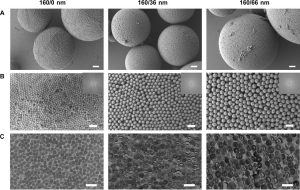There are countless examples of colouration via nanoscale texturing found in nature and it seems like a superior alternative to chemical pigmentation, however, developing a technique that would allow us to generate a wide range of structural colours has proven to be a difficult task.
Structural colours are produced by the scattering of light off nanoparticles, whereas pigmentary colours are produced through the absorption of light by molecules. The reason scientists are interested in structural colours is because they are less dependent on the use of toxic organic and metal-based materials and have proven to be more resistant to photo and chemical bleaching compared to pigmentary colours. In a recent study conducted by Dr. Xiao and a team of researchers, tiny balls of melanin were aggregated into clusters called ‘supraballs’. Individual nanoparticles of melanin are responsible for skin pigmentation and appear black, however, altering the spacing of the nanoparticles in the supraballs affects how light is scattered, thus generating a spectrum of structural colours.

Microstructures of supraballs – http://advances.sciencemag.org/content/3/9/e1701151.full
Altering the spacing of the nanoparticles was achieved by adding a thin silica shell to the surface of the nanoparticles to control how tightly packed they were. By varying the diameter of the silica coating, the nanoparticles formed differently nanostructured supraballs which were able to scatter light to produce a wide range of colours. Additionally, using nanoparticles of different dimensions allowed for the shading of colours to be altered. Melanin was chosen as the nanoparticle core due to its large refractive index (RI) and broadband absorption in the visible range, which reduces the scattering of incoherent light and subsequently increases colour purity. The high RI melanin core and low RI silica shell makes for higher reflectance and brighter, more vibrant colours.
One of the main reasons this finding is considered a breakthrough in structural colouration research is due to the simplicity of the technique used to create the supraballs. This technique contrasts previously known methods, which are far more complicated and do not have the same potential for commercial application. The silica-coated melanin nanoparticles self-assemble into supraballs clusters via a water-in-oil reverse emulsion process. The supraballs are then separated by centrifugation. This process does not rely on the use any surfactant molecules to stabilize the emulsion and is fast and easily scalable.
With all the benefits structural colours have over pigmentary colours, along with recent advances in techniques used to create the nanomaterials which generate these structural colours, it is only a matter of time before we see this technology go to market.
– Joseph Bergvinson
Citations:
Hamers, L. (2017, September). Tiny ‘supraballs’ put a new spin on creating long-lasting color. Science News. Retrieved from https://www.sciencenews.org/article/tiny-supraballs-put-new-spin-creating-long-lasting-color
Xiao, M., Hu, Z., Wang, Z., Li, Y., Tormo, A. D., Le, T. N., Wang, B., Gianneschi, N. C., Shawkey, M. D., Dhinojwala, A. (2017). Bioinspired Bright Nonirridescent Photonic Melanin Supraballs. Journal of Science Advances, 3(9). doi: 10.1126/sciadv.1701151
